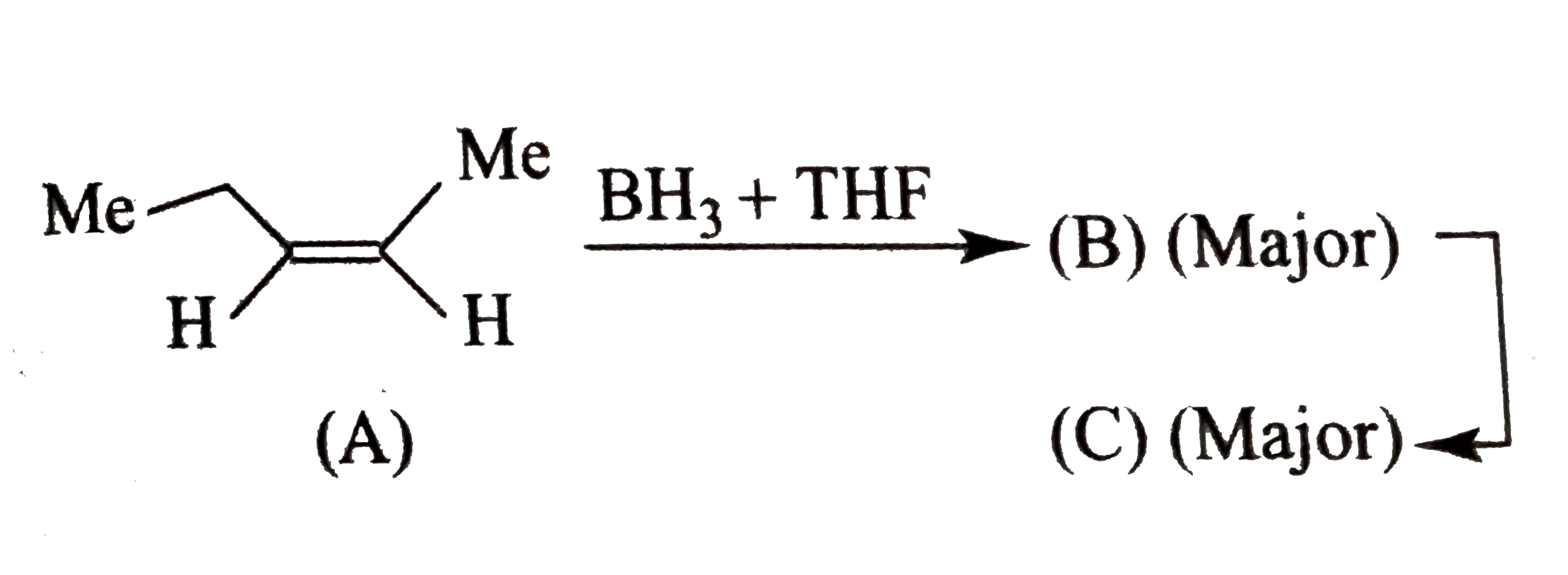A+dil.H2SO4Δ−−→gas(B). Gas(B) turns K2Cr2O7/H solution green.
Aq. solution of A+BaCl2→Whiteppt.(C)Filtrate after removing (C) + Br_(2)
water ⟶whiteppt(C). Here (A), (B) and (C) are
Identify(A),(B) and(C).
To solve the problem, we need to identify the substances A, B, and C based on the given reactions and observations. Let's break down the information step by step.
Step 1: Identify Gas B
The problem states that gas (B) is produced when substance (A) is treated with dilute sulfuric acid (H₂SO₄) and that gas (B) turns potassium dichromate (K₂Cr₂O₇) solution green.
1. Observation: The green color indicates a reduction reaction, where Cr(VI) from K₂Cr₂O₇ is reduced to Cr(III).
2. Conclusion: A common gas that can reduce Cr(VI) to Cr(III) is hydrogen sulfide (H₂S) or sulfur dioxide (SO₂). However, since we are looking for a substance that can react with dilute sulfuric acid to produce a gas, we can conclude that (A) is likely to be a sulfide, specifically hydrogen sulfide (H₂S).
Step 2: Identify Substance A
Since we suspect that gas (B) is hydrogen sulfide (H₂S), we can deduce that substance (A) must be a sulfide that can release H₂S when treated with dilute sulfuric acid.
1. Conclusion: A is likely to be a metal sulfide, such as zinc sulfide (ZnS) or iron(II) sulfide (FeS). For simplicity, let's assume (A) is zinc sulfide (ZnS).
Step 3: Identify White Precipitate C
The next part of the problem states that the aqueous solution of (A) plus barium chloride (BaCl₂) gives a white precipitate (C).
1. Observation: Barium chloride reacts with sulfates to form barium sulfate (BaSO₄), which is a white precipitate.
2. Conclusion: Since (A) is zinc sulfide, the white precipitate (C) formed with BaCl₂ is likely barium sulfate (BaSO₄).
Step 4: Analyze the Filtrate Reaction
The filtrate after removing (C) plus bromine water gives another white precipitate.
1. Observation: Bromine water can react with sulfides to form a precipitate of barium bromide (BaBr₂) or other bromides.
2. Conclusion: The white precipitate formed here could be barium bromide (BaBr₂) or another compound containing barium that precipitates in the presence of bromine.
Final Identification
- A: Zinc sulfide (ZnS)
- B: Hydrogen sulfide (H₂S)
- C: Barium sulfate (BaSO₄)
Summary of Identifications
- A = ZnS (Zinc sulfide)
- B = H₂S (Hydrogen sulfide)
- C = BaSO₄ (Barium sulfate)
The problem states that gas (B) is produced when substance (A) is treated with dilute sulfuric acid (H₂SO₄) and that gas (B) turns potassium dichromate (K₂Cr₂O₇) solution green.
2. Conclusion: A common gas that can reduce Cr(VI) to Cr(III) is hydrogen sulfide (H₂S) or sulfur dioxide (SO₂). However, since we are looking for a substance that can react with dilute sulfuric acid to produce a gas, we can conclude that (A) is likely to be a sulfide, specifically hydrogen sulfide (H₂S).
Since we suspect that gas (B) is hydrogen sulfide (H₂S), we can deduce that substance (A) must be a sulfide that can release H₂S when treated with dilute sulfuric acid.
The next part of the problem states that the aqueous solution of (A) plus barium chloride (BaCl₂) gives a white precipitate (C).
2. Conclusion: Since (A) is zinc sulfide, the white precipitate (C) formed with BaCl₂ is likely barium sulfate (BaSO₄).
The filtrate after removing (C) plus bromine water gives another white precipitate.
2. Conclusion: The white precipitate formed here could be barium bromide (BaBr₂) or another compound containing barium that precipitates in the presence of bromine.
- A: Zinc sulfide (ZnS)
- B: Hydrogen sulfide (H₂S)
- C: Barium sulfate (BaSO₄)
- A = ZnS (Zinc sulfide)
- B = H₂S (Hydrogen sulfide)
- C = BaSO₄ (Barium sulfate)
Similar Questions
a.(A) +KBr→ yellow ppt . (B)
(A) +conc.H2SO4Δ−−→ brown vapours intensifield with cu- turnings.
(B) dissolves in lypo forming a soluble complex (C ) what are (A),(B) and (C ) and explain their reactions ?
b. SO2−3 and SO2−4 both give while ppt with BaCI2 solution .How is SO2−3 detected in presence of SO2−4?
c. Na2B4O7.10H2O+conc.H2SO4Δ−−→(A)CH2OHΔ−−−−−→(B) idenity (A) and (B)
d. (A) +diiH2SO4Δ−−→gas(B)
Gas (B) turns K2Cr2O7/HΘ solution green Aq solution of (A) +BaCI2→ while ppt .(C )
Filltrate after removing (C) +Br2 water rarr while ppt dissolve in qammon ium acetate solution Example.View Solution H2O2+ΘOH
H2O2+ΘOH
B and C are:View Solution[X]+H2SO4→[Y] a colourless gas with irritating smell, [Y]+K2Cr2O7+H2SO4→ green solution.
[X] and [Y] are respectively :View SolutionH2S gas is passed through an acidic solution of K2Cr2O7 .The solution turns milky, why?
View SolutionZinc on reaction with NaOH gives a salt (A) along with a gas (B).
(A) on reaction with H2S gas gives a white precipitate (C ).
Identify (A), (B) and (C ).View Solution[X]+H2SO4→[Y] a colourless gas with irritating smell [Y]+K2Cr2O7+H2SO4→ green solution [X] and [Y] are
View Solution[X]+H2SO4→[Y] a colourless gas with irritating smell [Y]+K2Cr2O7+H2SO4→ green solution [X] and [Y] are
View SolutionH2C2O4Δ−−→ gas (A)+gas(B)+liquid(C) oxalic acid Gas (A) burns with blue flame and is oxidised to gas (B). Gas (B) turns lime water milky
Gas (A)+Cl2→(D)NH3.Δ−−−−→(E)NH3.ΔB
Identify (A) to (E) and explain reactions involved.View SolutionAK2Cr2O7−−−−−→H2SO4(CH3)2C=OO−−→CH3COOH ,
Here [A] is :View SolutionNH3+O2Pt−−→ΔA+H2O
A+O2→B,
B+O2+H2O→C
A, B and C are:View Solution

